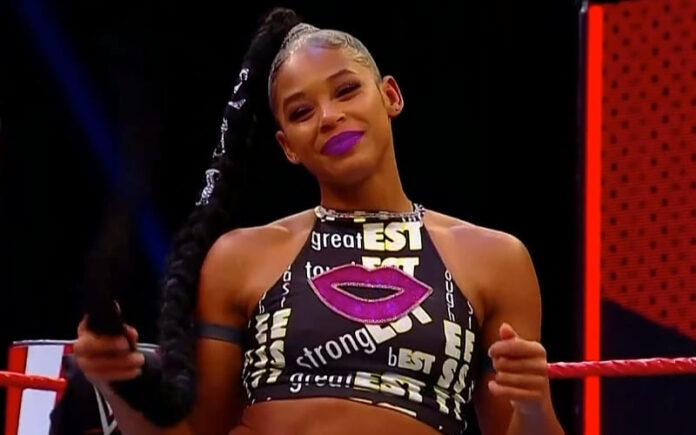
After the shock waves of not only the scandal that the Wall Street Journal broke about Vince McMahon’s alleged sexual misconduct and millions of dollars of payoffs to keep it all quiet, but also the news that Triple H took over as the head of creative for the WWE, many speculated about the direction of the organization. As we discussed in an article earlier this week, Summer Slam, the first pay-per-view in the post-Vince era, was quick to make a statement about the change in regime. Bayely, who was on the shelf for almost nine months because of a torn ACL, made her return to the company, alongside Io Sky and Dakota Kai, who was released in April. Among other things, Becky Lynch, who suffered an injury of her own and will be on the sidelines several months, turned baby face to bring back “The Man” persona that originally propelled her in popularity a few years ago. We also saw a wild main event that had a lot of sizzle, with the stunt that saw Brock Lesnar move the ring with a tractor before he was defeated by Roman Reigns in a last man standing match.
The aftermath on Raw had fans tune in to see what the chatter was about on social media. According to The Wrestling Observer’s Dave Meltzer, the show garnered a 2.2 rating, which is the best number of the year.
The number is very revealing because it proves a few things about the product, as well as the potential viewing audience. It goes without saying that the ratings of under two million for WWE’s flagship show would’ve been unthinkable in the past, but there are a number of factors that go into the equation. In 2003, when the Monday night show averaged around three million viewers, it was considered a sign of a wrestling recession since it was such a drastic drop from the record-setting ratings of just a few years prior. In the almost two decades since that time, the evolution of media played such a role in the way that viewers consume content and all of the dynamics around it. It can be a very complex topic, but to keep it on a surface level, the expansion of wifi and smart phones in the past 15 years had a major effect on how content is distributed, as well as how that process is monetized. Let’s not forget, one way or another, it still all comes down to the almighty dollar. The ability to stream content and more importantly, offer content on-demand, changed the way content is distributed and also how advertisers marketed their products to consumers. There was a time when commercial revenue was relatively cut and dry in that the shows with the highest ratings had the biggest ad revenue since more viewers translated to more exposure of a product. Now, getting those commercials to potential consumers has become more difficult, simply by the the multitude of avenues that can be used to get those ads seen. Buying commercial time on a podcast or ad space on a streaming platform is just as important as traditional advertising because the concept of on-demand content is so common in the modern era.
Why did the WWE land such massive TV contracts along with the Peacock deal?
As I’ve said before, it wasn’t the popularity of sports entertainment, but rather the dynamics of the television business that made it possible. By nature, live sports content is considered to be more DVR proof than most traditional shows, and the WWE produces nearly 200 live shows a years. Raw and Smackdown numbers are sluggish this year, but pro wrestling generally has a steady and consistent number, which is a safer bet for advertisers. The WWE Network has thousands of hours of content available at the push of a button, and thus commercial spots for all of those shows. We already know that the company will tout record-setting numbers based on those contracts alone, but what about the product in the future?
The 2.2 number isn’t great, but at a time when there are exponentially more options for viewers now than in the past, it’s at least a number that’s encouraging as far as a new chapter for the organization. The bigger story is that there’s undoubtedly a portion of the audience that would watch if the product gave them a reason to tune into the show. That proves that there are causal fans that keep an eye on the business, but usually aren’t going to tune in regularly. Three hours every week can be too much like a chore for viewers rather than an entertainment option. Still, the point is, there are definitely more fans willing to watch the show if they are given a quality product, which is why this past Monday did the best number of the year. Sure, it could’ve been an artifical bump from the pay-per-view or the news that Triple H took over after Vince’s public exit, but the biggest takeaway is, there’s a considerable part of the audience that is at least willing to watch sports entertainment if they are given a reason.
This is underscored by the fact that some of the retro aspects of the industry still have more main stream popularity than the current generation.
If or how WWE brass attempts to retain some of those casual fans that took a peek on Monday remains to be seen, but as I’ve said before, the women’s division is probably the company’s biggest asset right now. Becky Lynch, Bayley, Sasha Banks, and Bianca Belair could all be pop culture stars if given the right platform. Guys like Bron Breakker need a bigger stage and a fast track to the spotlight, especially with the lack of depth of star power on the main roster. Remember, there’s a different between in-ring talent and star power. The current roster arguably has the most in-ring talent in the history of the company, but ranks lower in star power. Essentially, management has to promote the competitors to their fullest potential to maximize the assets that the company has right now. Kevin Owens is a grappler that floundered at various points in his career, but make no mistake about it, he’s one of the most valuable commodities in the organization. The same can be said for Sami Zayn. There’s a reason why Owens was the guy that got paired with Steve Austin at Wrestlemania, the same way Sami didn’t get randomly picked to work with Johnny Knoxville. They aren’t typical Vince McMahon prototypes and maybe that’s why their success had peaks and valleys. However, the change in regime could lead to a change in philosophy.
Don’t get me wrong, there are members of the general public that don’t want anything to do with pro wrestling and wouldn’t watch it under any circumstances. That portion of the public is irrelevant since they aren’t the target audience, but the ratings for this past Monday proved that they are more potential viewers that would tune their television to Raw, and the WWE has the talent to draw them to the product so it will be interesting to see if the fresh chapter can find more of an audience.
What do you think? Share your thoughts, opinions, feedback, and anything else that was raised on Twitter @PWMania and Facebook.com/PWMania.
Until next week
-Jim LaMotta
E mail [email protected] | You can follow me on Twitter @jimlamotta







